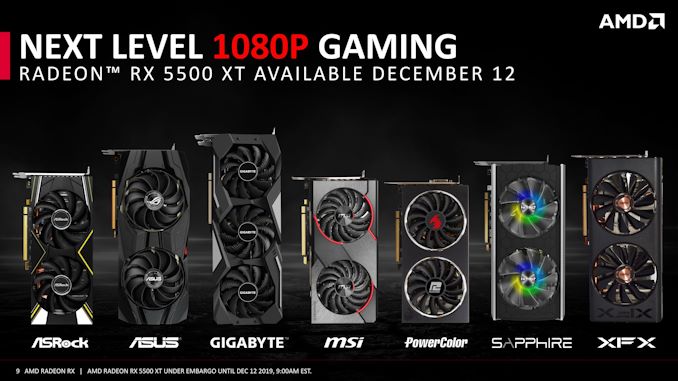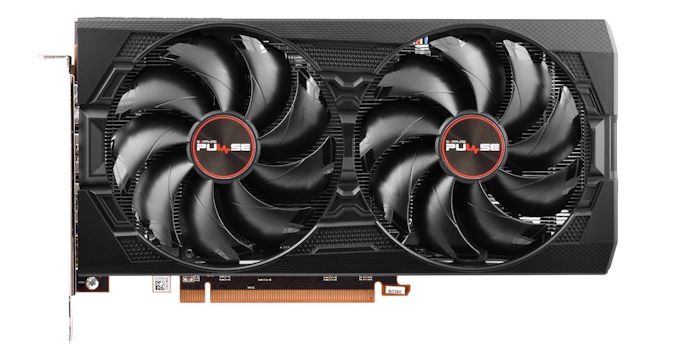The AMD Radeon RX 5500 XT Review, Feat. Sapphire Pulse: Navi For 1080p
by Ryan Smith on December 12, 2019 9:00 AM ESTClosing Thoughts
While the launch of the Radeon RX 5700 series and the underlying Navi 10 GPU was not a slam dunk for AMD’s GPU division, it was none the less an important achievement. The combination of the new RDNA core architecture as well as TSMC’s 7nm process gave AMD a significant kick in both performance efficiency and power efficiency. And in the process, it set a template for all the Radeon RX 5000 series cards to follow.
So it shouldn’t be too surprising then that the new Radeon RX 5500 XT gets to enjoy much the same situation. Compared to AMD’s previous generation Polaris-based RX 500 series cards, the 1080p-focused RX 5500 XT delivers better performance, and it does so while drawing noticeably less power. Even compared to their NVIDIA rivals, AMD is generally competitive on power efficiency in a class of cards where they were well behind in the previous generation.
Competitive performance, meanwhile, is a bit of a trickier subject. As the replacements to the RX 570/580/590 within AMD’s stack, the RX 5500 XT almost always beats AMD’s older cards, the one odd exception to this being Metro Exodus. As a result, AMD’s cheaper 4GB RX 5500 XT looks especially good here, reaching performance parity with NVIDIA’s recently launched and similarly priced GeForce GTX 1650 Super. As is usually the case, the cards are anything but equal on a game-by-game basis, constantly trading wins and losses, but at the end of the day they’re fighting over the same market with the same performance.
The 8GB RX 5500 XT, on the other hand, faces tougher competition. The extra VRAM helps to boost its performance and its price, putting it in competition with NVIDIA’s somewhat awkwardly placed GTX 1660. The GTX 1660 is an odd man out as the only current-generation GDDR5 card among the contenders, and yet it’s still fast enough to remain several percent ahead of the 8GB RX 5500 XT. To be sure, AMD’s new card puts up a great fight, coming closer to meeting NVIDIA in both performance and power efficiency than any previous AMD card; but at the end of the day it’s not enough to completely close the gap with NVIDIA’s closest competitor. Which is not to say that the RX 5500 XT is entirely outclassed here, but the GTX 1660 leads by just enough that it can’t be entirely ignored.
| Performance Summary (1080p) | ||||
| Relative Performance | Relative Price |
|||
| RX 5500 XT 4GB vs GTX 1650S | 0% | +6% | ||
| RX 5500 XT 8GB vs GTX 1660 | -8% | -5% | ||
| RX 5500 XT 8GB vs RX 580 8GB | +8% | +11% | ||
| RX 5700 vs. RX 5500 XT 8GB | +60% | +60% | ||
Throwing a wrench into all of this however – for both AMD and NVIDIA – is VRAM capacity. VRAM isn’t cheap, and GDDR6 even less so, so both vendors are using VRAM capacity as product differentiators and to upsell their better cards. But as VRAM capacity in the $150-$200 price range has been pretty stagnant for the last couple of years now, I do have some concerns about the long-term implications for the 4GB RX 5500 XT, especially with the next-generation consoles set to launch in a year’s time. With the consoles setting the baseline for most multiplatform games, it’s a reasonable bet that VRAM requirements aren’t going to stay put at 4GB much longer. So while the 4GB RX 5500 XT is a great value now, I suspect it’s going to run out of VRAM well before its compute performance gets to be a bottleneck. And while NVIDIA’s GTX 1660 fares better here with its 6GB of VRAM, 6GB is still not 8GB.
Overall then, the VRAM situation adds an extra wrinkle to any kind of product recommendations, as it’s one more variable that deserves consideration.
At the end of the day, I don’t think any 4GB cards are a great choice right now. For buyers who absolutely cannot afford to spend more than $169, then the 4GB RX 5500 XT or NVIDIA’s GeForce GTX 1650 Super counterpart are both going to be the best choices you can make right now, at least among the current-generation cards. However, spending another $30 to get a better card is going to get you a card with at least 6GB of VRAM and 6% more perforamnce, and that’s going to remain relevant for a lot longer than a 4GB card will in 2020.
Choosing between the 8GB RX 5500 XT and GTX 1660, on the other hand, is a bit harder. AMD has a 2GB VRAM advantage, which is likely to be helpful in the future; but right now they can’t match NVIDIA’s performance or feature advantage. Ultimately I’m not sure there’s a clearly correct answer here – at least, not one that can be backed entirely with hard data. In the meantime however, as the second to market it's up to AMD to make a convincing showing if they want to dislodge NVIDIA's existing GTX 1660.
As for Sapphire’s Pulse RX 5500 XT in particular, it’s hard to envision a better card to show off the Radeon RX 5500 XT. If you can look past the card’s somewhat ridiculous size for its class, the product as a whole is just about everything you could want out of a reference clocked card. The build quality is solid, the included TriXX software is handy, and the acoustics are incredible. It may not be a silent card, but with two giant fans to push plenty of air with ease, it may just as well be.
And with that, AMD is set to wrap up their GPU lineup for 2019. At only 3 Navi cards in, AMD is far from done in fleshing out a complete, top-to-bottom family of video cards. But for now, AMD is able to hit the mainstream and performance segments, which is a good place to stop for a bit and reflect as we go into the holidays.












97 Comments
View All Comments
Valantar - Thursday, December 12, 2019 - link
What? This class of GPU is in no way whatsoever capable of gaming at 4K. Why include a bunch of tests where the results are in the 5-20fps range? That isn't useful to anyone.Zoomer - Saturday, December 21, 2019 - link
AT used to include. I just ignored it for a card of this class; probably others did as well.Ravynmagi_ - Thursday, December 12, 2019 - link
I lean more Nvidia too and I didn't get that impression from the article. I felt it was fair to AMD and Nvidia in it's comparison of the performance and facts. I wasn't bothered by where they decided to cut off their chart.FreckledTrout - Friday, December 13, 2019 - link
Same here. I don't need to see numbers elucidating how bad these low end cards are at 4k. Let's move on.Dragonstongue - Thursday, December 12, 2019 - link
I <3 how compute these days adamantly refuse to use the "old standard"i.e MINING
this shows Radeon in vastly different light, as the different forms of such absolutely show difference generation on generation, more so Radeon than Ngreedia err I mean Nvidia.
seeing as one can take the wee bit of time to have a -pre set that really needs very little change (per brand and per specific GPU being used)
instead of using "canned" style bechmarks, that often are very much *bias* towards those who hold more market share and/or have the heavier fist to make sure they are shown as "best" even when the full story simply is NOT being fully told...yep am looking direct at INTC/NVDA ... business is business, they certainly walk that BS line constantly, to very damaging consequence for EVERYONE
............
I personally think in this regard, AMD likely would have been "best off" to up the power budget a wee touch, so the "clear choice" between going with older stuff they probably and likely not want to be producing as much anymore (likely costlier) that is RX 4/5xx generation such as the 570-580 more importantly 590, this "little card" would be that much better off, instead, they seem to "adamant" want to target the same limiting factor of limited memory bus size (even though fast VRAM) still wanting to be @ the "claimed golden number" of "sub" $200 price point --- means USA or this price often moves from "acceptable" to, why bother when get older far more potent stuff for either not much more or as of late, about the same (rarely less, though it does happen)
1080p, I can see this, myself still using a Radeon 7870 on a 144Hz monitor "~3/4" jacked up settings (granted it is not running at full rate as the GPU does not support run this at full speed, but my Ryzen 3600 helps huge.
still, a wee bit more power budget or something would effectively "bury" or make moot 580 - 590, then wanting to sell for that "golden" $200 price point, would make much more sense, seeing as they launched the 480 - 580 "at same pricing" (for USA) in my mind, and all I have read, with the terrific yields TSMC has managed to get as well as the "reasonable low cost to produce due to very very few "errors" THIS should have targeted 175 200 max.
They are a business, no doubt, though they in all honesty should have looked at the "logical side" that is, "we know we cannot take down the 1660 super / Ti the way we would like to, while sticking with the shader count / memory bus, so why not say fudge it, add that extra 10w (effectively matching 7870 from many many generations back in the real world usage) so we at least give potential buyers a real hard time to decide between an old GPU (570-580-590) or a brand spanking new one that is very cool running AND not at all same power use, I am sure it will sell like hotcakes, provided we do what we can to make sure buyers everywhere can get this "for the most part" at a guaranteed $200 or less price point, will that not tick our competition right off?"
..........
thesavvymage - Thursday, December 12, 2019 - link
What are you even trying to say here.....Valantar - Thursday, December 12, 2019 - link
I was lost after the first sentence. If it can be called a sentence. I truly have no idea what this rant is about.Fataliity - Thursday, December 12, 2019 - link
I think the game bundle is what they chose as their selling point. I'm sure they get a good deal with game pass being the supplier of CPU/GPU on xbox. So their bundle is most likely almost free for them. Which pushes the value up. Without bundle I imagine 5500 4gb being 130 and 8gb being 180.TheinsanegamerN - Sunday, December 15, 2019 - link
That's a LOTTA words just to say "AMD just made another 580 for $20 less, please clap."kpb321 - Thursday, December 12, 2019 - link
The ~$100ish 570's still look like a great deal as long as they are still available. For raw numbers they have basically the same memory bandwidth and compute as a 5500 but the newer card ends up being slightly faster and uses a bit less power. It is overall more efficient but IMO no where near enough to justify the price premium over the older cards. I'm not as sure that the 570/580 or 5500 will have enough compute power for the 4 vs 8gb of memory to really make a difference but my 570 happens to be an 8gb card anyway.